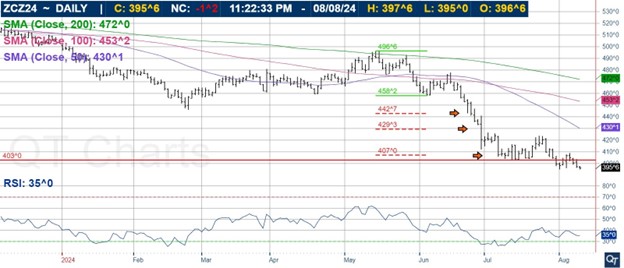Has the market reached rock bottom -- we don't think so!
By Devin Lashley
U.S. corn prices have been experiencing a downward spiral, driven by various factors such as favorable weather conditions, increased yield forecasts, higher production and ending stocks and a lack of strong export demand, particularly from China.
Despite the belief that corn may have already hit its lowest point, there are indications that the market has not yet reached rock bottom and that further declines are possible in the coming months with more upside in 2024 U.S. yields.
One of the primary reasons for the pressure on corn prices is the growing yield potential of U.S. crops. Favorable weather conditions, including adequate rainfall and mild temperatures, have supported crop development, leading to higher yield expectations with a record yield at 225 bpa in Illinois according to the USDA in the August crop report: 11 bpa higher than the last record in 2022 at 214 bpa.
Crop condition reports have consistently shown strong ratings, with U.S. corn crops rated 67 percent good-to-excellent (G-E) and 68 percent G-E for soybeans well above the long-term average. This has fueled optimism about a bumper harvest, further pushing prices down.
Additionally, the U.S. weekly corn exports have been strong up 34 percent vs. last year but it not large enough to offset growing corn supplies. The lack of significant export business, especially from China, has added to the bearish sentiment.
Although there are rumors of potential Chinese purchases in October, uncertainty surrounding U.S.-China trade relations, particularly in the event of a potential trade war under a Trump presidency, has dampened expectations for aggressive buying.
The favorable weather forecast for August, which is expected to maintain the high-end yield potential of U.S. crops, has also contributed to the bearish outlook. U.S. crops are progressing well, with 70-80% of the corn crop pollinated under good conditions. The recent weather has been non-threatening, with scattered rains and cooler temperatures expected to support grain fill. Only a small portion (5 percent) of U.S. corn acreage is currently experiencing drought conditions, further reinforcing the potential for a strong harvest.
Technical indicators also suggest that corn prices may continue to decline. December 2024 corn futures have broken below the $4.00/bushel important psychological mark, signaling further downside potential. A weekly close below $3.97/bu is a new technical long-term sell signal, pointing to a potential low of $2.90/bu by October 2024. Historical patterns indicate that it is rare for corn prices to hit their yearly low in July, suggesting that further declines are likely in the coming months.

Source: QT Charts
The absence of any significant catalyst to reverse the bearish trend adds to the pessimism. Speculative funds are defending their short positions, and with no reason to change the pattern they will continue to sell and defend their record monster short position. The ag recession is already evident, and the bearish trend in corn prices is expected to persist.
In conclusion, while corn prices have already seen significant declines, it is unlikely that they have hit rock bottom. Favorable weather conditions, strong yield potential (too many are underestimating the U.S. 2024 crop yields), and weak export demand continue to exert downward pressure on prices as prices search for more demand.
With technical indicators pointing to further declines and no clear catalyst to change the bearish trend, corn prices could continue to fall in the coming months, potentially reaching new lows by October 2024. Farmers and traders should remain cautious and consider protective strategies to mitigate potential losses as the market remains under the control of bearish forces.
For daily information and updates on agriculture commodity marketing and price risk management for North American farmers, producers, and agribusiness visit the Farms.com Risk Management Website to subscribe to the program.